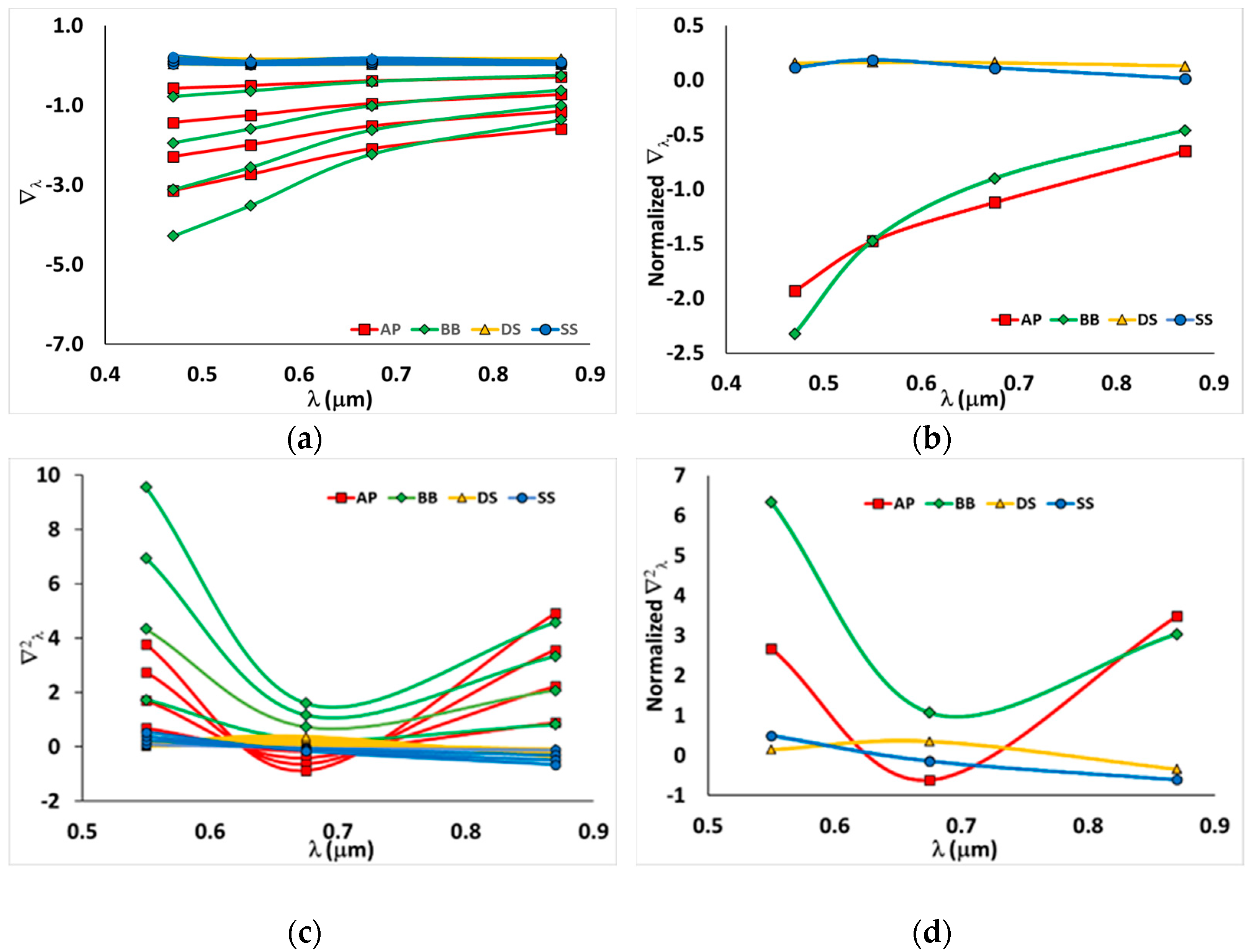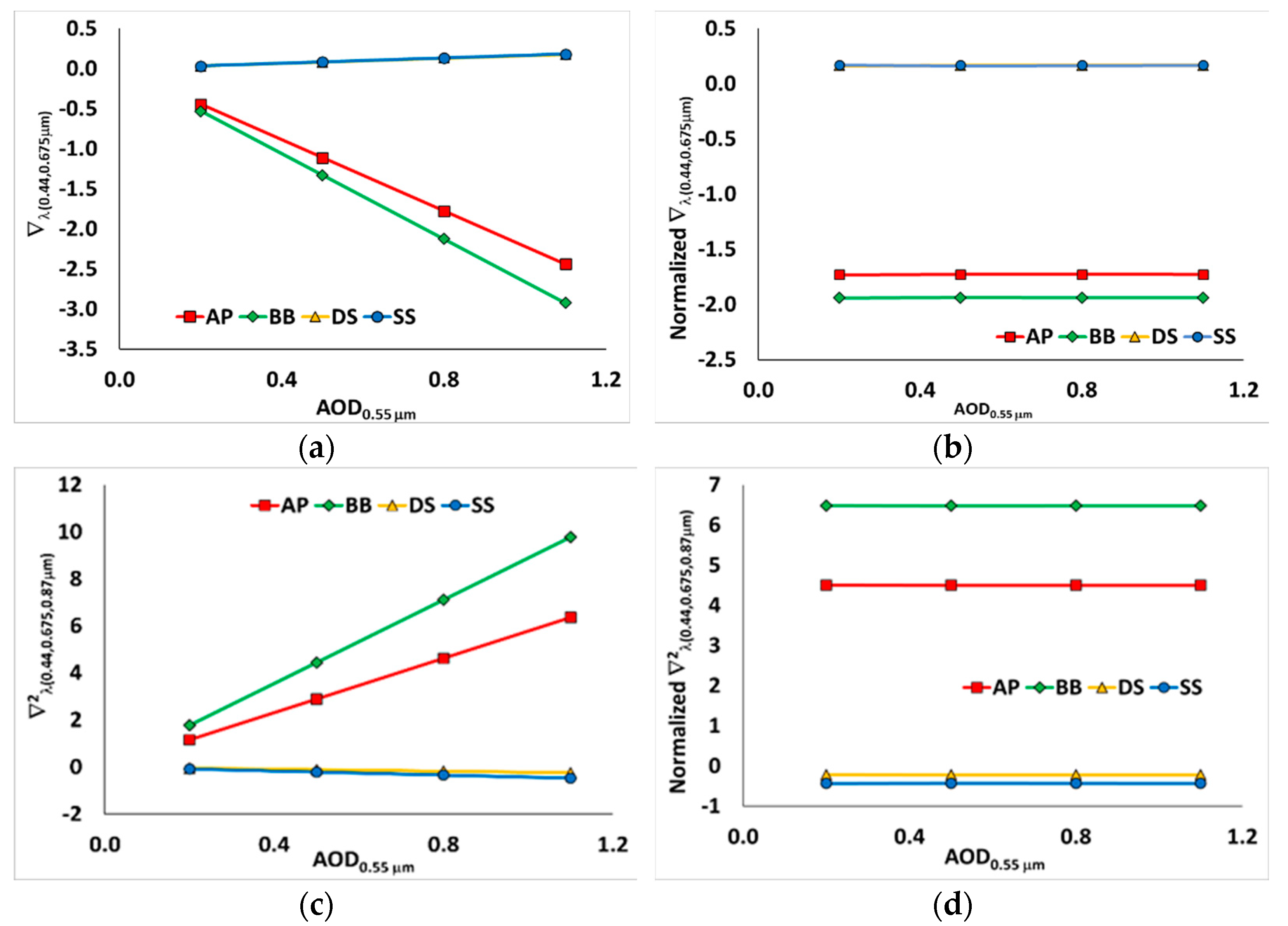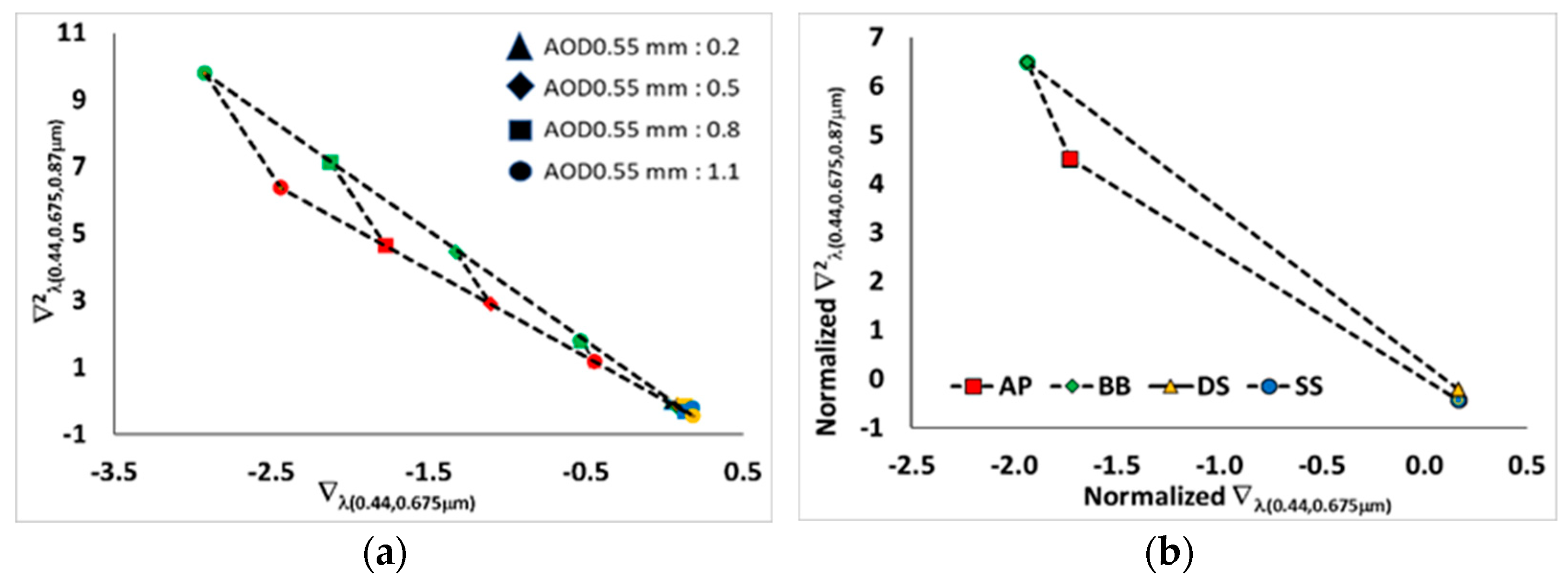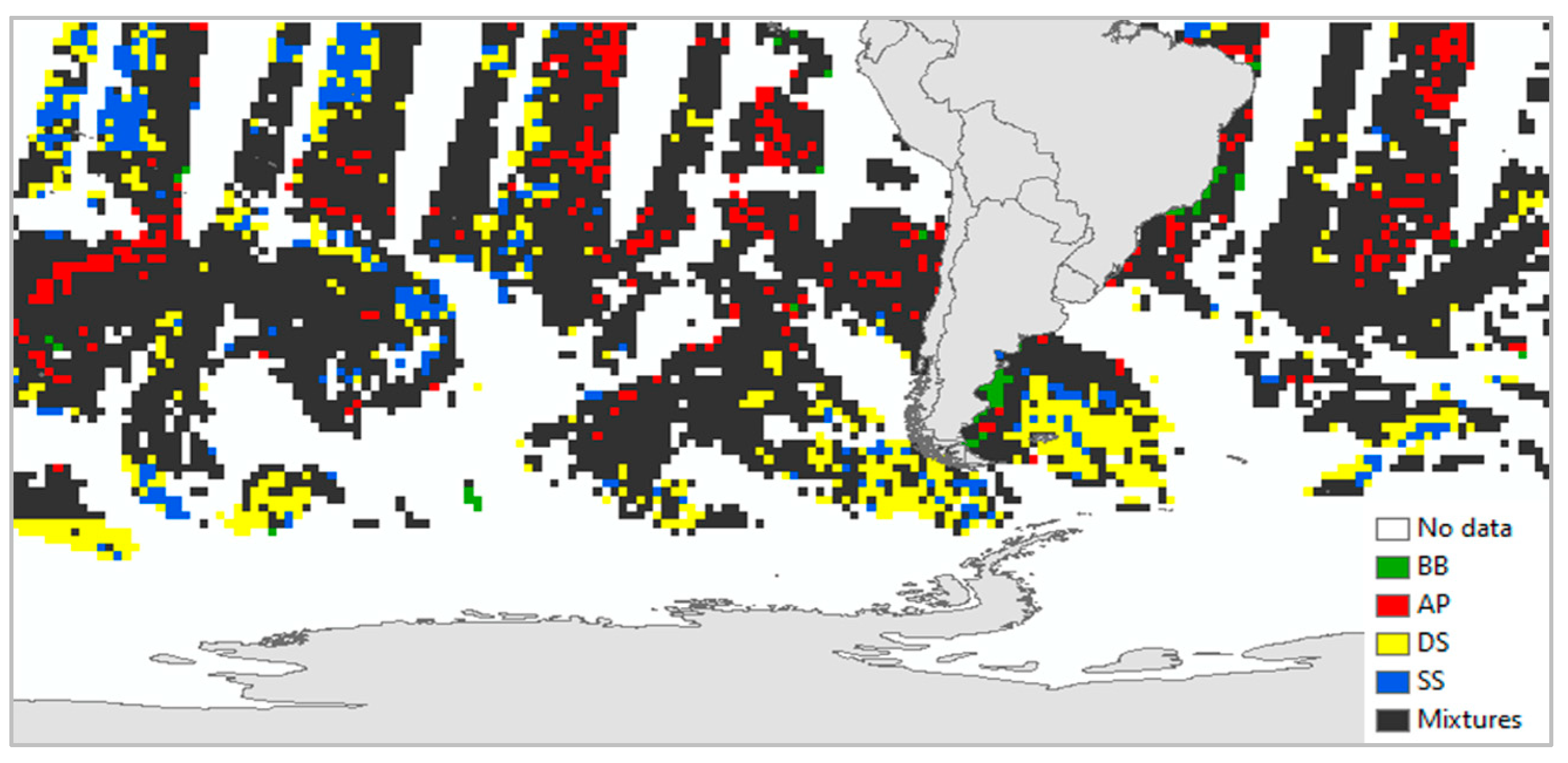Sea Salt Aerosol Identification Based on Multispectral Optical Properties and Its Impact on Radiative Forcing over the Ocean
Abstract
:1. Introduction
2. Methodology
2.1. Experiment of Theoretical Simulation
2.2. Spectral Derivatives of AOD
2.3. Shortwave Aerosol Direct Radiative Forcing and Efficiency
3. Measurements
3.1. In Situ Aerosol Measurements
3.2. Spaceborne Aerosol Observations
4. Results and Analysis
4.1. Theoretical Spectral AOD Derivatives
4.2. Measurements for Spectral AOD Derivatives
4.3. Measurements from Satellite Observations
5. Conclusions
- Of the forcing agents in the aerosol group listed in the Fifth Assessment IPCC report, the aerosol species were dominated by anthropogenic sources in our study. Mineral dust was the only natural one (see Supplement Material Figure S1). This result suggests that future research should consider searching for other natural aerosols (e.g., sea salt over the ocean) and their impact on the climate. However, aerosol research over the ocean has significant limitations, such as no in situ measurements predominantly over the open ocean on a regular basis, which results in the reliance on satellite measurements. It has been widely known that climate change is linked to changes in wind patterns with increases in near surface wind speed, rise in sea surface temperature, and change in salinity [47], which in turn affect the emissions and distribution of SS. Transported SS will undergo heterogeneous reactions with anthropogenic aerosols (e.g., nitrate and sulphate), forming secondary aerosols which potentially have quite different physicochemical properties than the original aerosols. Consequently, the secondary aerosols will pose markedly different radiative forcing directly and indirectly [7,10].
- Spectral derivatives were beneficial as a substitute for absent SSA in MODIS aerosol products over the ocean and were not affected by the absence of aerosol segregation over the ocean. The availability of satellite-derived aerosol products at various spatial and temporal resolutions has increased in recent years due to low-Earth-orbit satellites. Aerosol categorization using particle size without considering radiative properties will skew the results. Aerosol portioning is required to accurately estimate aerosol radiative forcing.
- Spectral derivatives explored the characteristics of each aerosol type through absorption between the wavelength pairs. Aerosol loadings governed the magnitude of spectral derivatives such as NDAI (Figure 4a). Based on Equation (2), NDAI was a function of particle size (Angstrom exponent) and also the first-order derivative of AODs at a logarithmic scale. The second-order derivatives compensated for the absence of SSA, and successfully partitioned aerosols based on their radiative characteristics. After normalization, the spectral derivatives converged and had their own individual values that served to differentiate them (Figure 4b).
- The simulation of a radiative transfer model such as the 6S model was advantageous to experiment or predict the radiative transfer of light-scattering absorption through the Earth’s atmosphere, according to the response variables used for fitting. However, in this study, there was a slight discrepancy in magnitudes between the spectral derivatives calculated from the 6S model and the satellite measurements (AERONET and satellite observation). This minor disagreement was due to the 6S model being operated under ideal atmospheric conditions. Nevertheless, a comparison of the results from simulation and the observation showed they were similar.
- SS had similarities to DS including its optical particle size and its imaginary part of the refractive index, but after normalization, both had their own individual optical characteristics. The particle size computed from longer wavelength pairs (e.g., AE(0.675–1.02μm), AE(0.87,2.13μm)) could illustrate more obvious differences in magnitudes between DS and SS. BB and AP were less complicated to discriminate, as although they have similar particle sizes, they have different radiative effects.
- Each aerosol species indicated different characteristics in radiative forcing and efficiency at the TOA, the BOA, and the atmosphere itself. Radiative forcing is dependent not only on the amount of radiation entering the atmosphere but also on the mass concentration of aerosol perturbing the atmosphere. To remove the influence of aerosol loading in the calculations of radiative forcing, AOD0.55μm was used to normalize the radiative forcing, which is called radiative forcing efficiency. At the TOA, SS had the smallest magnitude, −36 W/m2, while AP had the lowest magnitude at the BOA but the highest in the atmosphere, with −66.2 and 32.5 W/m2, respectively. In addition, the relationship between AOD0.55μm and radiative forcing efficiency was illustrated to compare the forcing abilities of the different aerosol types. The relationships were marked by negative slopes indicating negative relationships. When the AOD0.55μm was increasing, the SWARFE was decreasing, and vice versa. Figure 7b,c shows the relationship between RF and AOD0.55μm for the different aerosol types. The slopes of the best-fit line, shown by dashed lines, give the average forcing efficiency, as estimated by Equation (7). SS generated the most efficient radiative cooling effects, as it had the steepest slope, on the TOA among the three aerosol types. For instance, when the AOD0.55μm is 0.2, the aerosol RFs from SS, BB, DS, and AP are estimated to be −7.35, −6.73, −6.19, and −6.04 W/m2, respectively. This means that with the same magnitude of AOD0.55μm, SS produced the strongest cooling effect at TOA compared to the other aerosol species. At BOA, AP had the greatest cooling effect among the other three aerosol constituents. The emissions and corresponding radiative effects of SS will change dynamically depending on the availability of driving factors such as global warming and climate change.
- MODIS aerosol products (e.g., MOD04_L2, MOD08_D3) providing daily observations of AOD globally can overcome the absence or limited coverage from surface monitoring, particularly over the ocean. It can be used to monitor the spatial and temporal distribution of SS and other aerosol types. The first- and second-order derivatives calculated from spectral AODs can be useful and practical tools to compensate the absence of SSA due to the dark target algorithm applied for AOD retrieval over the ocean. In addition, the spectral derivatives optimistically discriminate major components of aerosol species (e.g., BB, AP, DS, SS) and map out their distributions and corresponding radiative forcings. Continuing global aerosol monitoring over the ocean is required to better understand the spatio-temporal distribution of aerosol types and their radiative effects in a changing climate.
Supplementary Materials
Author Contributions
Funding
Data Availability Statement
Acknowledgments
Conflicts of Interest
References
- Liu, S.; Liu, C.-C.; Froyd, K.D.; Schill, G.P.; Murphy, D.M.; Bui, T.P.; Dean-Day, J.M.; Weinzierl, B.; Dollner, M.; Diskin, G.S.; et al. Sea spray aerosol concentration modulated by sea surface temperature. Proc. Natl. Acad. Sci. USA 2021, 118, e2020583118. [Google Scholar] [CrossRef]
- Schiffer, J.M.; Mael, L.E.; Prather, K.A.; Amaro, R.E.; Grassian, V.H. Sea spray aerosol: Where marine biology meets atmospheric chemistry. ACS Cent. Sci. 2018, 4, 1617–1623. [Google Scholar] [CrossRef]
- Andreae, M.O.; Jones, C.D.; Cox, P.M. Strong present-day aerosol cooling implies a hot future. Nature 2005, 435, 1187–1190. [Google Scholar] [CrossRef] [PubMed]
- Boucher, O.D.; Randall, P.; Artaxo, C.; Bretherton, G.; Feingold, P.; Forster, V.-M.; Zhang, X.Y. Clouds and Aerosols. In Climate Change 2013: The Physical Science Basis. Contribution of Working Group I to the Fifth Assessment Report of the Intergovernmental Panel on Climate Change; Cambridge University Press: Cambridge, UK; New York, NY, USA, 2013. [Google Scholar]
- Frey, M.M.; Norris, S.J.; Brooks, I.M.; Anderson, P.S.; Nishimura, K.; Yang, X.; Wolff, E.W. First direct observation of sea salt aerosol production from blowing snow above sea ice. Atmos. Chem. Phys. 2020, 20, 2549–2578. [Google Scholar] [CrossRef] [Green Version]
- Metzger, S.; Mihalopoulos, N.; Lelieveld, J. Importance of mineral cations and organics in gas-aerosol partitioning of reactive nitrogen compounds: Case study based on MINOS results. Atmos. Chem. Phys. 2006, 6, 2549–2567. [Google Scholar] [CrossRef] [Green Version]
- Liao, H.; Seinfeld, J.H. Global impacts of gas-phase chemistry-aerosol interactions on direct radiative forcing by anthropogenic aerosols and ozone. J. Geophys. Res. 2005, 110, D18208. [Google Scholar] [CrossRef] [Green Version]
- Xu, L.; Penner, J.E. Global simulations of nitrate and ammonium aerosols and their radiative effects. Atmos. Chem. Phys. 2012, 12, 9479–9504. [Google Scholar] [CrossRef] [Green Version]
- Lowe, D.; Archer-Nicholls, S.; Morgan, W.; Allan, J.; Utembe, S.; Ouyang, B.; Aruffo, E.; Le Breton, M.; Zaveri, R.A.; Di Carlo, P.; et al. WRF-Chem model predictions of the regional impacts of N2O5 heterogeneous processes on night-time chemistry over north-western Europe. Atmos. Chem. Phys. 2015, 15, 1385–1409. [Google Scholar] [CrossRef] [Green Version]
- Chen, Y.; Cheng, Y.; Ma, N.; Wei, C.; Ran, L.; Wolke, R.; Größ, J.; Wang, Q.; Pozzer, A.; Denier van der Gon, H.A.; et al. Natural sea-salt emissions moderate the climate forcing of anthropogenic nitrate. Atmos. Chem. Phys. 2020, 20, 771–786. [Google Scholar] [CrossRef] [Green Version]
- IPCC. Climate Change 2013: The Physical Science Basis. Contribution of Working Group I to the Fifth Assessment Report of the Intergovernmental Panel on Climate Change; Report; Stocker, T.F., Qin, D.H., Plattner, G.K., Tignor, M.M.B., Allen, S.K., Boschung, J., Nauels, A., Xia, Y., Bex, V., Midgley, P.M., Eds.; Cambridge University Press: New York, NY, USA, 2013; Available online: http://www.ipcc.ch/report/ar5 (accessed on 21 June 2022).
- Struthers, H.; Ekman, A.M.L.; Glantz, P.; Iversen, T.; Kirkevåg, A.; Seland, Ø.; Mårtensson, E.M.; Noone, K.; Nilsson, E.D. Climate-induced changes in sea salt aerosol number emissions: 1870 to 2100. J. Geophys. Res. Atmos. 2013, 118, 670–682. [Google Scholar] [CrossRef]
- Smirnov, A.; Holben, B.N.; Kaufman, Y.J.; Dubovik, O.; Eck, T.F.; Slutsker, I.; Pietras, C.; Halthore, R.N. Optical properties of atmospheric aerosol in maritime environments. J. Atmos. Sci. 2002, 59, 501–523. Available online: https://journals.ametsoc.org/view/journals/atsc/59/3/1520-0469_2002_059_0501_opoaai_2.0.co_2.xml (accessed on 21 May 2022). [CrossRef] [Green Version]
- Quinn, P.K.; Coffman, D.J.; Kapustin, V.N.; Bates, T.S.; Covert, D.S. Aerosol optical properties in the marine boundary layer during the First Aerosol Characterization Experiment (ACE 1) and the underlying chemical and physical aerosol properties. J. Geophys. Res. 1998, 103, 16547–16563. [Google Scholar] [CrossRef]
- Platnick, S.; King, M.; Meyer, K.G.; Wind, G.; Amarasinghe, N.; Marchant, B.; Arnold, G.T.; Zhang, Z.; Hubanks, P.A.; Ridgway, B.; et al. MODIS Atmosphere L3 Daily Product. In NASA MODIS Adaptive Processing System; Goddard Space Flight Center: Greenbelt, MD, USA, 2015. [Google Scholar] [CrossRef]
- Sayer, A.M.; Hsu, N.C.; Lee, J.; Kim, W.V.; Dutcher, S.T. Validation, stability, and consistency of MODIS collection 6.1 and VIIRS version 1 Deep Blue aerosol data over land. J. Geophys. Res. Atmos. 2019, 124, 4658–4688. [Google Scholar] [CrossRef]
- Zhou, Y.; Levy, R.C.; Remer, L.A.; Mattoo, S.; Shi, Y.; Wang, C. Dust aerosol retrieval over the oceans with the MODIS/VIIRS Dark-Target algorithm: 1. Dust detection. Earth Space Sci. 2020, 7, e2020EA001221. [Google Scholar] [CrossRef]
- Kim, M.-H.; Omar, A.H.; Tackett, J.L.; Vaughan, M.A.; Winker, D.M.; Trepte, C.R.; Hu, Y.; Liu, Z.; Poole, L.R.; Pitts, M.C.; et al. The CALIPSO version 4 automated aerosol classification and lidar ratio selection algorithm. Atmos. Meas. Tech. 2018, 11, 6107–6135. [Google Scholar] [CrossRef] [PubMed] [Green Version]
- Winker, D.M.; Pelon, J.; Coakley, J.A., Jr.; Ackerman, S.A.; Charlson, R.J.; Colarco, P.R.; Flamant, P.; Fu, Q.; Hoff, R.M.; Kittaka, C.; et al. The CALIPSO mission: A global 3D view of aerosols and clouds. Bull. Amer. Meteor. Soc. 2010, 91, 1211–1229. [Google Scholar] [CrossRef]
- Balarabe, M.; Abdullah, K.; Nawawi, M. Seasonal variations of aerosol optical properties and identification of different aerosol types based on AERONET data over Sub-Sahara West-Africa. Atmos. Clim. Sci. 2015, 6, 13–28. [Google Scholar] [CrossRef] [Green Version]
- Boselli, A.; Caggiano, R.; Cornacchia, C.; Madonna, F.; Mona, L.; Macchiato, M.; Pappalardo, G.; Trippetta, S. Multi year sun-photometer measurements for aerosol characterization in a Central Mediterranean site. Atmos. Res. 2012, 104, 98–110. [Google Scholar] [CrossRef]
- Eck, T.; Holben, B.; Reid, J.; Dubovik, O.; Smirnov, A.; O’neill, N.; Slutsker, I.; Kinne, S. Wavelength dependence of the optical depth of biomass burning, urban, and desert dust aerosols. J. Geophys. Res. Atmos. 1999, 104, 31333–31349. [Google Scholar] [CrossRef]
- Kalapureddy, M.C.R.; Kaskaoutis, D.G.; Raj, P.E.; Devara, P.C.S.; Kambezidis, H.D.; Kosmopoulos, P.G.; Nastos, P.T. Identification of aerosol type over the Arabian Sea in the premonsoon season during the Integrated Campaign for Aerosols, Gases and Radiation Budget (ICARB). J. Geophys. Res. Atmos. 2009, 114, D17203. [Google Scholar] [CrossRef] [Green Version]
- Lin, T.-H.; Tsay, S.-C.; Lien, W.-H.; Lin, N.-H.; Hsiao, T.-C. Spectral derivatives of optical depth for partitioning aerosol type and loading. Remote Sens. 2021, 13, 1544. [Google Scholar] [CrossRef]
- Kokhanovsky, A. Aerosol Optics: Light Absorption and Scattering by Particles in the Atmosphere; Springer Praxis: Chichester, UK, 2008; p. 2163. [Google Scholar]
- Montilla, E.; Mogo, S.; Cachorro, V.; Lopez, J.; de Frutos, A. Absorption, scattering and single scattering albedo of aerosols obtained from in situ measurements in the subarctic coastal region of Norway. Atmos. Chem. Phys. Discuss. 2011, 11, 2161–2182. [Google Scholar] [CrossRef] [Green Version]
- Huang, X.; Song, Y.; Zhao, C.; Li, M.; Zhu, T.; Zhang, Q.; Zhang, X. Pathways of sulfate enhancement by natural and anthropogenic mineral aerosols in China. J. Geophys. Res. Atmos. 2014, 119, 14165–14179. [Google Scholar] [CrossRef]
- Li, L.; Li, Z.; Chang, W.; Ou, Y.; Goloub, P.; Li, C.; Li, K.; Hu, Q.; Wang, J.; Wendisch, M. Aerosol solar radiative forcing near the Taklimakan Desert based on radiative transfer and regional meteorological simulations during the Dust Aerosol Observation-Kashi campaign. Atmos. Chem. Phys. 2020, 20, 10845–10864. [Google Scholar] [CrossRef]
- Kotchenova, S.; Vermote, E. Validation of a vector version of the 6S radiative transfer code for atmospheric correction of satellite data. Part II: Homogeneous Lambertian and anisotropic surfaces. Appl. Opt. 2007, 46, 4455–4464. [Google Scholar] [CrossRef] [PubMed] [Green Version]
- Kotchenova, S.; Vermote, E.; Matarrese, R.; Klemm, F., Jr. Validation of a vector version of the 6S radiative transfer code for atmospheric 470 correction of satellite data. Part I: Path radiance. Appl. Opt. 2006, 45, 6762–6774. [Google Scholar] [CrossRef] [PubMed] [Green Version]
- Smirnov, A.; Holben, B.N.; Giles, D.M.; Slutsker, I.; O’Neill, N.T.; Eck, T.F.; Macke, A.; Croot, P.; Courcoux, Y.; Sakerin, S.M.; et al. Maritime aerosol network as a component of AERONET—First results and comparison with global aerosol models and satellite retrievals. Atmos. Meas. Tech. 2011, 4, 583–597. [Google Scholar] [CrossRef] [Green Version]
- Hansell, R.A.S.-C.; Tsay, P.; Pantina, J.R.; Lewis, Q.J.; Herman, J.R. Spectralderivative analysis of solar spectroradio-metric measurements: Theoretical basis. J. Geophys. Res. Atmos. 2014, 119, 8908–8924. [Google Scholar] [CrossRef]
- Ångström, A. The parameters of atmospheric turbidity. Tellus 1964, 16, 64–75. [Google Scholar] [CrossRef] [Green Version]
- Altaratz, O.; Bar-Or, R.Z.; Wollner, U.; Koren, I. Relative humidity and its effect on aerosol optical depth in the vicinity of convective clouds. Environ. Res. Lett. 2013, 8, 034025. [Google Scholar] [CrossRef]
- Gassó, K.S.; Hegg, D.A.; Covert, D.S.; Collins, D.; Noone, K.J.; Öström, E.; Schmid, B.; Russell, P.B.; Livingston, J.M.; Durkee, P.A.; et al. Influence of humidity on the aerosol scattering coefficient and its effect on the upwelling radiance during ACE-2. Tellus B Chem. Phys. Meteorol. 2000, 52, 546–567. [Google Scholar] [CrossRef]
- Xue, Z.; Kuze, H.; Irie, H. Retrieval of aerosol optical thickness with custom aerosol model using SKYNET Data over the Chiba area. Atmosphere 2021, 12, 1144. [Google Scholar] [CrossRef]
- Zhang, L.; Li, J.; Jiang, Z.; Dong, Y.; Ying, T.; Zhang, Z. Clear-sky direct aerosol radiative forcing uncertainty associated with aerosol vertical distribution based on CMIP6 models. J. Clim. 2022, 35, 3021–3035. [Google Scholar] [CrossRef]
- Pilinis, C.K.; Seinfeld, J.H.; Grosjean, D. Water content of atmospheric aerosols. Atmos Environ. 1989, 23, 1601–1606. [Google Scholar] [CrossRef]
- Cheng, Y.F.; Wiedensohler, A.; Eichler, H.; Heintzenberg, J.; Tesche, M.; Ansmann, A.; Wendisch, M.; Su, H.; Althausen, D.; Herrmann, H.; et al. Relative humidity dependence of aerosol optical properties and direct radiative forcing in the surface boundary layer at Xinken in Pearl River Delta of China: An observation based numerical study. Atmos. Environ. 2008, 42, 6373–6397. [Google Scholar] [CrossRef]
- Topping, D.O.; McFiggans, G.B.; Coe, H. A curved multi-component aerosol hygroscopicity model framework: Part 1—Inorganic compounds. Atmos. Chem. Phys. 2005, 5, 1205–1222. [Google Scholar] [CrossRef] [Green Version]
- Topping, D.O.; McFiggans, G.B.; Coe, H. A curved multicomponent aerosol hygroscopicity model framework: Part 2—Including organic compounds. Atmos. Chem. Phys. 2005, 5, 1223–1242. [Google Scholar] [CrossRef] [Green Version]
- Ramachandran, S.; Srivastava, R. Influences of external vs. core-shell mixing on aerosol optical properties at various relative humidities. Environ. Sci. Process. Impacts 2013, 15, 1070–1077. [Google Scholar] [CrossRef]
- Ghahremaninezhad, R.; Gong, W.; Galí, M.; Norman, A.-L.; Beagley, S.R.; Akingunola, A.; Zheng, Q.; Lupu, A.; Lizotte, M.; Levasseur, M.; et al. Dimethyl sulfide and its role in aerosol formation and growth in the Arctic summer—A modelling study. Atmos. Chem. Phys. 2019, 19, 14455–14476. [Google Scholar] [CrossRef] [Green Version]
- Bullard, J.E.; Baddock, M.; Bradwell, T.; Crusius, J.; Darlington, E.; Gaiero, D.; Gassó, S.; Gisladottir, G.; Hodgkins, R.; McCulloch, R.; et al. High-latitude dust in the Earth system. Rev. Geophys. 2016, 54, 447–485. [Google Scholar] [CrossRef] [Green Version]
- McGregor, D. Book review: World atlas of desertification, 2nd edn., edited by N. J. Middleton and D. S. G. Thomas. Arnold, London for United Nations Environment Programme, 1997. ISBN 0-34069166-2, £145·00 (hardback), x+182 pp. Land Degrad. Dev. 1999, 10, 177–178. [Google Scholar] [CrossRef]
- Mirzabaev, A.; Wu, J.; Evans, J.; Garcia-Oliva, F.; Hussein, I.A.; Iqbal, M.H.; Kimutai, J.; Knowles, T.; Meza, F.; Nedjraoui, D.; et al. Desertification. In Climate Change and Land: An IPCC Special Report on Climate Change, Desertification, Land Degradation, Sustainable Land Management, Food Security, and Greenhouse Gas Fluxes in Terrestrial Ecosystems; Shukla, P.R., Skea, J., Buendia, E.C., Masson-Delmotte, V., Pörtner, H.-O., Roberts, D.C., Zhai, P., Slade, R., Connors, S., van Diemen, R., et al., Eds.; IPCC: Geneva, Switzerland, 2019; in press. [Google Scholar]
- Rhein, M.S.R.; Rintoul, S.; Aoki, E.; Campos, D.; Chambers, R.A.; Feely, S.; Gulev, G.C.; Johnson, S.A.; Josey, A.; Kostianoy, C.; et al. Observations: Ocean. In Climate Change 2013: The Physical Science Basis. Contribution of Working Group I to the Fifth Assessment Report of the Intergovernmental Panel on Climate Change; Stocker, T.F., Qin, D., Plattner, G.-K., Tignor, M., Allen, S.K., Boschung, J., Nauels, A., Xia, Y., Bex, V., Midgley, P.M., Eds.; Cambridge University Press: Cambridge, UK; New York, NY, USA, 2013. [Google Scholar]







| Location | Time Span | Aerosol Type |
|---|---|---|
| Tahiti (17.6°S, 149.6°W) | 1999–2009 | SS |
| Nauru (0.5°S, 166.9°E) | 1999–2007 | SS |
| American Samoa (14.2°S, 170.6°W) | 2014–2017 | SS |
| Guam (13.4°N, 144.8°E) | 2006–2009 | SS |
| Midway Island (28.2°N, 177.4°W) | 2001–2014 | SS |
| Lanai (20.7°N, 156.9°W) | 1996–2004 | SS |
| Sensor | Data | Time | Study Area |
|---|---|---|---|
| MODIS | MOD04_L2 and MOD08_D3 spectral over-ocean AODs: 0.47, 0.55, 0.66, 0.87, 1.24, 1.64, and 2.13 μm | 25 August 2017 | 0–90°S 0–180°W |
| CALIPSO | VFM: vertical aerosol subtypes | 25 August 2017 | 0–90°S 0–180°W |
| CERES | SYN1DEG: TOA and BOA shortwave Fluxes | 25 August 2017 | 0–90°S 0–180°W |
| Aerosol Intrinsic Characteristics | AP | BB | DS | SS |
|---|---|---|---|---|
| AOD0.44μm | 0.83 ± 0.43 | 0.89 ± 0.46 | 0.64 ± 0.33 | 0.63 ± 0.33 |
| AE(0.44–0.675μm) | 1.21 | 1.42 | 0.089 | 0.087 |
| ∇τλ(0.44,0.675,τ(ref)=0.44μm) | −1.73 | −1.94 | 0.166 | 0.170 |
| ∇τλ(0.44,0.675,τ(ref)=0.675μm) | −2.9 | −3.55 | 0.160 | 0.162 |
| ∇τλ(0.44,0.675,τ(ref)=0.87μm) | −4.37 | −5.0 | 0.156 | 0.159 |
| ∇τλ(0.44,0.675,τ(ref)=1.02μm) | −5.8 | −6.01 | 0.153 | 0.159 |
| AE(0.675–1.02μm) | 1.79 | 1.24 | 0.113 | 0.013 |
| ∇τλ(0.87,1.02,τ(ref)=0.44μm) | −0.65 | −0.46 | 0.129 | 0.014 |
| ∇τλ(0.87,1.02,τ(ref)=0.675μm) | −1.09 | −0.84 | 0.124 | 0.014 |
| ∇τλ(0.87,1.02,τ(ref)=0.87μm) | −1.65 | −1.19 | 0.121 | 0.013 |
| ∇τλ(0.87,1.02,τ(ref)=1.02μm) | −2.19 | −1.45 | 0.118 | 0.013 |
| Aerosol Intrinsic Characteristics | Tahiti n = 20 | Nauru n = 97 | A. Samoa n = 25 | Guam n = 15 | Midway Island, n = 83 | Lanai n = 195 |
|---|---|---|---|---|---|---|
| AOD0.44μm | 0.06 ± 0.02 | 0.075 ± 0.04 | 0.069 ± 0.02 | 0.077 ± 0.02 | 0.083 ± 0.04 | 0.072 ± 0.02 |
| AE(0.44–0.675μm) | 0.028 ± 0.12 | 0.045 ± 0.01 | 0.091 ± 0.05 | 0.079 ± 0.08 | 0.09 ± 0.09 | 0.045 ± 0.08 |
| ∇τλ(0.44,0.675,τ(ref)=0.44μm) | 0.057 ± 0.22 | 0.078 ± 0.18 | −0.163 ± 0.09 | −0.14 ± 0.15 | −0.158 ± 0.18 | −0.038 ± 0.23 |
| ∇τλ(0.44,0.675,τ(ref)=0.675μm) | 0.05 ± 0.21 | 0.087 ± 0.17 | −0.169 ± 0.11 | −0.149 ± 0.15 | −0.171 ± 0.16 | −0.05 ± 0.21 |
| ∇τλ(0.44,0.675,τ(ref)=0.87μm) | 0.049 ± 0.22 | 0.085 ± 0.21 | −0.169 ± 0.13 | −0.154 ± 0.15 | −0.169 ± 0.17 | −0.049 ± 0.22 |
| ∇τλ(0.44,0.675,τ(ref)=1.02μm) | 0.047 ± 0.21 | 0.086 ± 0.18 | −0.171 ± 0.10 | −0.159 ± 0.17 | −0.169 ± 0.16 | −0.03 ± 0.63 |
| AE(0.675–1.02μm) | 0.268 ± 0.19 | 0.644 ± 0.74 | 0.413 ± 0.30 | 0.605 ± 0.43 | 0.421 ± 0.39 | 0.424 ± 0.38 |
| ∇τλ(0.87,1.02,τ(ref)=0.44μm) | 0.240 ± 0.19 | 0.540 ± 0.65 | 0.362 ± 0.26 | 0.506 ± 0.37 | 0.375 ± 0.38 | 0.387 ± 0.38 |
| ∇τλ(0.87,1.02,τ(ref)=0.675μm) | 0.290 ± 0.24 | 0.650 ± 0.72 | 0.422 ± 0.30 | 0.635 ± 0.46 | 0.479 ± 0.50 | 0.454 ± 0.42 |
| ∇τλ(0.87,1.02,τ(ref)=0.87μm) | 0.292 ± 0.22 | 0.776 ± 1.03 | 0.460 ± 3.40 | 0.690 ± 0.51 | 0.477 ± 0.47 | 0.479 ± 0.45 |
| ∇τλ(0.87,1.02,τ(ref)=1.02μm) | 0.274 ± 0.19 | 0.611 ± 0.62 | 0.417 ± 0.29 | 0.598 ± 0.40 | 0.421 ± 0.37 | 0.424 ± 0.36 |
| Aerosol Intrinsic Characteristics | AP n = 314 | BB n = 51 | DS n = 656 | SS n = 190 |
|---|---|---|---|---|
| AE(0.47,0.66μm) | 1.18 ± 0.08 | 2.34 ± 0.35 | 0.11 ± 0.13 | 0.08 ± 0.09 |
| ∇τλ(0.47,0.66,τ(ref)=0.47μm) | −1.66 ± 0.05 | −2.77 ± 0.19 | −0.26 ± 0.14 | 0.11 ± 0.18 |
| ∇τλ(0.47,0.66,τ(ref)=0.66μm) | −2.42 ± 0.12 | −5.91 ± 0.86 | −0.28 ± 0.15 | 0.10 ± 0.16 |
| ∇τλ(0.47,0.66,τ(ref)=0.86μm) | −3.41 ± 0.25 | −12.05 ± 3.62 | −0.30 ± 0.16 | 0.10 ± 0.17 |
| AE(0.87,2.13μm) | 1.01 ± 0.35 | 1.43 ± 0.59 | 0.41 ± 0.24 | 0.61 ± 0.10 |
| ∇τλ(0.87,2.13,τ(ref)=0.47μm) | −0.22 ± 0.04 | −0.14 ± 0.02 | −0.21 ± 0.10 | −0.31 ± 0.04 |
| ∇τλ(0.87,2.13,τ(ref)=0.87μm) | −0.46 ± 0.09 | −0.59 ± 0.13 | −0.23 ± 0.12 | −0.33 ± 0.04 |
| ∇τλ(0.87,2.13,τ(ref)=2.13μm) | −1.27 ± 0.79 | −2.54 ± 2.41 | −0.37 ± 0.24 | −0.58 ± 0.11 |
Publisher’s Note: MDPI stays neutral with regard to jurisdictional claims in published maps and institutional affiliations. |
© 2022 by the authors. Licensee MDPI, Basel, Switzerland. This article is an open access article distributed under the terms and conditions of the Creative Commons Attribution (CC BY) license (https://creativecommons.org/licenses/by/4.0/).
Share and Cite
Atmoko, D.; Lin, T.-H. Sea Salt Aerosol Identification Based on Multispectral Optical Properties and Its Impact on Radiative Forcing over the Ocean. Remote Sens. 2022, 14, 3188. https://doi.org/10.3390/rs14133188
Atmoko D, Lin T-H. Sea Salt Aerosol Identification Based on Multispectral Optical Properties and Its Impact on Radiative Forcing over the Ocean. Remote Sensing. 2022; 14(13):3188. https://doi.org/10.3390/rs14133188
Chicago/Turabian StyleAtmoko, Dwi, and Tang-Huang Lin. 2022. "Sea Salt Aerosol Identification Based on Multispectral Optical Properties and Its Impact on Radiative Forcing over the Ocean" Remote Sensing 14, no. 13: 3188. https://doi.org/10.3390/rs14133188








